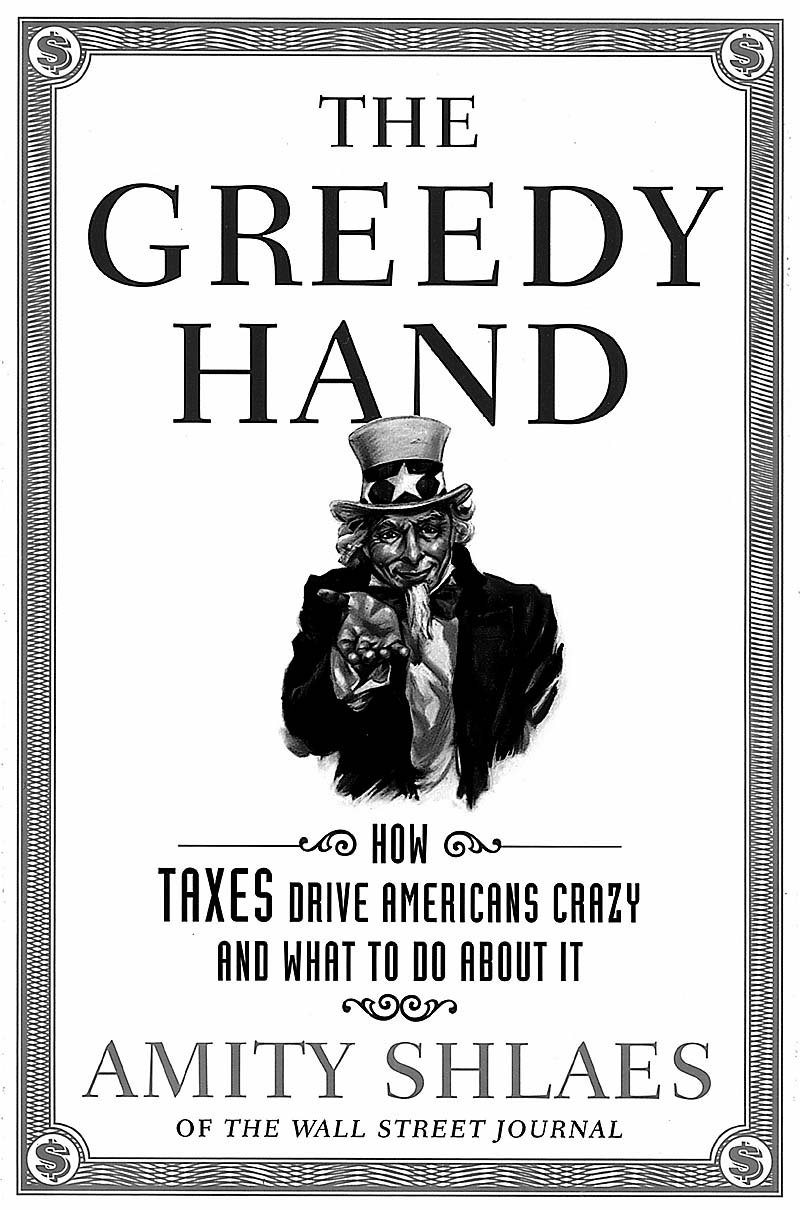By Amity Shlaes
Random House
255 pages
"... Adam Smith described the 'invisible hand,' the hand of free commerce that brings magic order and harmony to our lives. Thomas Paine wrote of another hand, all too visible and intrusive: 'the greedy hand of government, thrusting itself into every corner and crevice of industry.' ..."
 Amity Shlaes, Wall Street Journal editorialist,
in The Greedy Hand, provides a thoughtful,
penetrating and delightfully irreverent exposé of
current American systems of taxation, their origins, their
ironies and their many, many unintended consequences.
Amity Shlaes, Wall Street Journal editorialist,
in The Greedy Hand, provides a thoughtful,
penetrating and delightfully irreverent exposé of
current American systems of taxation, their origins, their
ironies and their many, many unintended consequences.
She points out that tax policies in the 1940s and thereafter have assumed a dominant and often perverse role in the evolution of U.S. society. A simpler, fairer, more understandable structure is needed to bring government and its revenue-collection system into better alignment with the needs, wants and interests of the public.
Thoroughly researched and documented, this compact volume traces the economic, social and ultimately the political factors that have come to rest in the current tax regime. And while the Internal Revenue Service acts as the popular focal point for people's tax displeasure, Ms. Shlaes notes that it is the tax code itself, with its myriad loopholes, exceptions and special-interest provisions, all enacted in the spirit of democratic compromise, that burdens Americans of every economic and social estate with unnecessarily complicated bureaucratic intrusions from womb to tomb.
Pointed illustrations are offered of economic and behavioral anomalies that flow from current tax structures. For example, home mortgage interest deductibility provides a huge subsidy to investors in real estate. Without that subsidy, overall rates would likely be lower and investment would flow more efficiently. Another example is the fact that increasingly complicated tax provisions caused more than half of taxpayers in 1997 to pay professionals to prepare their returns, a huge expenditure that could be avoided with a simpler tax code. In addition, confiscatory estate tax rates prompt costly and economically unproductive legal stratagems by individuals and businesses to reduce or eliminate those taxes.
Ms. Shlaes notes that American history is rife with examples of public protests against taxes perceived as excessive, unnecessary or unfair. However, the installation of the income tax withholding system in 1943 changed all that. Marketed initially as a temporary wartime measure to help patriotic Americans "pay as you go" for wartime needs, withholding minimized the impact, the awareness and the public concern about tax levels. In succeeding years, the needs of the Cold War and the Great Society, among others, served as a rationale for continued high levels of government expenditure. Not surprisingly, few politicians favored tinkering with the withholding program. However, with the end of the Cold War, the re-emergence of a strong private economy and public support for limits on the role of government, Ms. Shlaes believes the time is propitious for a return to a simpler, less costly, more visible tax structure.
Her case for fundamental change is persuasive. Given a clean slate, I doubt that anyone, liberal or conservative, would deliberately replicate the system that Ms. Shlaes so aptly critiques. The devil is in mustering the political will to perform radical surgery on a system that has become so firmly entrenched.
The first hurdle would be to persuade the public at large that fundamental change is needed and is feasible. That's a tall order considering the powerful economic and political interests involved, among them:
- Accountants, tax collectors, tax attorneys and tax preparers.
- Housing industry participants; lenders, investors, advocates
and homeowners.
- Charities, foundations, trust administrators, their boards
and supporters.
- Politicians, whose ongoing capacity to adjust the tax code is an important element in their appeal to voters and supporters.
Should a simplified proposal be drafted that can attract broad public support, I believe that a thoughtful transition plan and a multiyear timetable would be needed. The economic dislocations that would follow a sudden or unplanned change to a simplified tax code could dwarf those that followed the tax reforms of the 1980s.
I like Ms. Shlaes' emphasis on visibility as an element in controlling the "greedy hand," and I agree that withholding diminishes visibility. However, for all its philosophical weaknesses, I can't imagine a U.S. tax system without withholding. The public would be unlikely to accept a system that restores more "pain" to the tax process, even if they are told it's better for them.
With regard to Social Security, Ms. Shlaes proposes privatizing the investment of at least 3 percentage points of each individual's contributions. That strikes me as a sound and politically feasible move away from the investment limitations of the current system.
One need not agree with all of Ms. Shlaes' perspectives to enjoy and admire the contribution she has made to an informed dialogue about tax policy. She offers timely and creative encouragement to those working toward a more rational U.S. tax structure.





